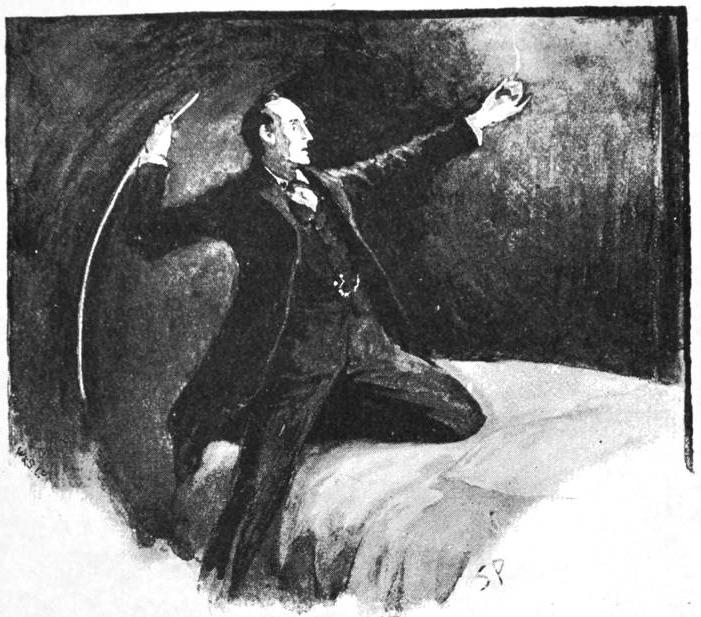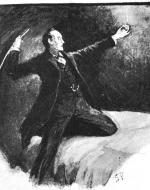Created by Yousef Farhang on Mon, 10/12/2020 - 20:21
Description:
Sidney Paget, a British illustrator in the Victorian era, is most famously known for his illustrations of Sir Arthur Conan Doyle’s Sherlock Holmes. The image above is one of Paget’s 9 vignettes included in “The Adventure of the Speckled Band” featured in The Adventures of Sherlock Holmes which was released on February 1892 in The Strand Magezine .This specific vignette depicts the moment in which the iconic Sherlock Holmes “[springs] from the bed, [strikes] a match, and lashe[s] furiously with his cane at the bell-pull” (Doyle 205). The phrase “HOLMES LASHED FURIOUSLY” is placed under the vignette, allowing Paget to further guild the reader to the visualized content, leaving no room for a false interpretation by the reader to what the image is referring to. Crafted in the photomechanical half-tone contemporary sketch style, Paget uses the narratological theory of picture-text relation in which the image often repeats the key features of Doyle’s mystery genre. Thus, since the image is mainly iterative of the text, Paget’s decision to only include Holmes in this image is vital to the analysis of text and image relationship. In fact, when compared to other illustrated images in the same chapter, there is never a moment in which Holmes is not accompanied by Dr. Watson. Paget’s deliberate decision to include Holmes alone in this vignette is reflective of the illustrator’s authority over how they represent the scenes in the text. Here, Paget is giving us Sherlock Holmes from the perspective of Dr. Watson. This illustrates a submissive interpretation of the illustrator from the text as it is in fact Dr. Watson who is narrating the story; therefore, we get to see Sherlock Holmes from Dr. Watson’s perspective when he is about to attack the mysterious bell-pull. Furthermore, the illustration avoids being proleptic in order to avoid spoiling or giving any clues to the mystery Holmes has already discovered. This decision not only encourages the reader to continue reading the story, it is also reflective of Watson’s role as the narrator influencing Paget’s illustration. In essence, since Dr. Watson himself has no idea what Holmes has figured out until the very end of the story, and since this vignette is illustrated from the point of view of Dr. Watson, Sidney does not disrupt this coherency between text and image by omitting the bell-pull with the snake on it in his sketch since Dr. Watson did not see the snake. Instead, he allows the illumination of Holmes’ match to completely cover the bell-pull which is interesting because while the word “illustration” used to mean to illuminate, Paget’s illumination is doing the exact opposite. Instead of illuminating new clues for the reader, it is hiding the bell-pull in order to keep the story’s mystery alive by placing Holmes in the centre of the image, alone, mid-action while he is about to overcome the mystery of the case. Therefore, Paget’s illustrations are able to further reinforce Doyle’s convections of Sherlock Holmes as a defining character in detective fiction.
Prinicpal Sources:
http://www.victorianweb.org/art/illustration/pagets/111.html
https://www.bl.uk/romantics-and-victorians/articles/arthur-conan-doyle-t...
https://archive.org/details/adventuresofsher001892doyl/page/206/mode/2up...
Copyright:
Associated Place(s)
Timeline of Events Associated with Sidney Paget, "Holmes Lashed Furiously" The Adventures of Sherlock Holmes (1892)
Part of Group:
Featured in Exhibit:
Artist:
- SIDNEY PAGET


